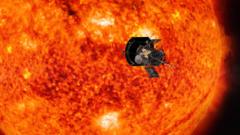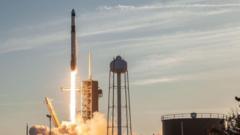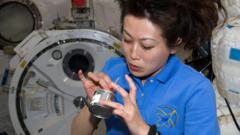The spacecraft, launched in 2018, is set to enter the Sun's atmosphere while enduring extreme temperatures and radiation.
**Parker Solar Probe Makes Historic Endeavor to Touch the Sun**

**Parker Solar Probe Makes Historic Endeavor to Touch the Sun**
NASA's Parker Solar Probe aims to achieve a record-setting fly-by closer to the Sun than ever before.
The Parker Solar Probe is on a groundbreaking mission to approach the Sun closer than any spacecraft has ever gone before. This historic endeavor sees the probe entering the Sun's outer atmosphere, called the corona, where it will face scorching temperatures and intense radiation. Currently, the spacecraft is out of communication during its important Christmas Eve fly-by, with scientists eagerly awaiting a signal on December 27 to confirm its safe passage.
As Dr. Nicola Fox, head of science at NASA, clarified, “We can't really experience the atmosphere of our star unless we fly through it.” The Parker Solar Probe, which has previously made 21 passes around the Sun, will reach a record distance of just 3.8 million miles (6.2 million kilometers) from the Sun’s surface on this mission, a distance equivalent to four centimeters if the Sun and Earth were separated by a meter.
During its journey, the probe will endure temperatures soaring to 1,400°C (2,532°F), relying on an 11.5 cm (4.5 inches) thick carbon-composite shield for protection. Further, it will sting through space at an incredible speed of 430,000 mph—fast enough to travel from London to New York in less than half a minute.
The primary objective of this audacious mission is to unravel the solar mysteries surrounding the corona, which perplexes scientists with temperatures in the millions of degrees, despite being further away from the Sun than its surface. Dr. Jenifer Millard from Fifth Star Labs emphasizes the importance of this knowledge, stating, "Understanding the Sun, its activity, space weather, the solar wind, is so important to our everyday lives on Earth."
As researchers wait in anticipation over the holidays, they remain hopeful that the Parker Solar Probe will offer invaluable insights into solar phenomena that affect Earth, including solar wind, which can disrupt communications and power supplies. Dr. Fox confessed her worries but expressed confidence in the probe’s resilience, stating, "It's a tough, tough little spacecraft." As the world watches, this incredible mission stands to deepen our understanding of the Sun and its importance to life on Earth.
As Dr. Nicola Fox, head of science at NASA, clarified, “We can't really experience the atmosphere of our star unless we fly through it.” The Parker Solar Probe, which has previously made 21 passes around the Sun, will reach a record distance of just 3.8 million miles (6.2 million kilometers) from the Sun’s surface on this mission, a distance equivalent to four centimeters if the Sun and Earth were separated by a meter.
During its journey, the probe will endure temperatures soaring to 1,400°C (2,532°F), relying on an 11.5 cm (4.5 inches) thick carbon-composite shield for protection. Further, it will sting through space at an incredible speed of 430,000 mph—fast enough to travel from London to New York in less than half a minute.
The primary objective of this audacious mission is to unravel the solar mysteries surrounding the corona, which perplexes scientists with temperatures in the millions of degrees, despite being further away from the Sun than its surface. Dr. Jenifer Millard from Fifth Star Labs emphasizes the importance of this knowledge, stating, "Understanding the Sun, its activity, space weather, the solar wind, is so important to our everyday lives on Earth."
As researchers wait in anticipation over the holidays, they remain hopeful that the Parker Solar Probe will offer invaluable insights into solar phenomena that affect Earth, including solar wind, which can disrupt communications and power supplies. Dr. Fox confessed her worries but expressed confidence in the probe’s resilience, stating, "It's a tough, tough little spacecraft." As the world watches, this incredible mission stands to deepen our understanding of the Sun and its importance to life on Earth.




















